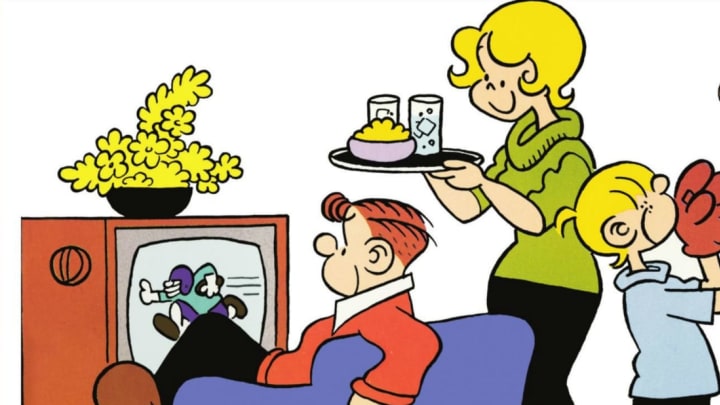A comics page staple for nearly 65 years, Mort Walker and Dik Browne’s Hi and Lois is a celebration of the mundane. Married couple Hiram “Hi” Flagston, wife Lois, and their four children balance work, school, and family dynamics, all of it with few punchlines but plenty of relatable situations. This four-panel ode to suburbia might appear simple, but it still has a rich history involving a beef with The Flintstones, broken noses, and one very important candy bar wrapper.
1. IT’S A SPINOFF OF BEETLE BAILEY.
Beetle Bailey creator Mort Walker had been drawing that military-themed strip for four years when a friend of his named Lew Schwartz approached him in 1954 with a new idea: Why not create a strip about a nuclear family? Around the same time, the Korean War was ending, and Walker had sent Beetle home on furlough to visit his sister, Lois. Drawing a line between the two, Walker decided to pursue the suburbia idea using Lois as connective tissue. Hi and Lois was born: The two strips would see their respective characters visit one another over the years.
2. A CANDY BAR HELPED DEFINE THE STRIP’S LOOK.
Already working on Beetle Bailey, Walker decided to limit his work on Hi and Lois to writing. He wanted to collaborate with an artist, and so both he and his syndicate, King Features, went searching for a suitable partner. Walker soon came across ads for both Lipton’s tea and Mounds candy bars that had the same signature: Dik Browne. Coincidentally, a King Features executive named Sylvan Byck saw a strip in Boy’s Life magazine also signed by Browne. The two agreed he was a talent and invited Browne to work on the strip.
3. HI ORIGINALLY HAD A BROKEN NOSE.
As an artist, Walker had plenty of input into the style of Hi and Lois: Browne would later recall that trying to merge his own approach with Walker’s proved difficult. “When you draw a character like Hi, for instance, you immediately set the style for the whole strip,” he said. “You have already dictated what a tree will look like or how a dog will look, just by sketching that one head.” In his earliest incarnation, Hi had a broken, upturned nose to make him seem virile, puffed on a pipe, and wore a vest. Through trial and error, the two artists eventually settled on the softer lines the strip still uses today, an aesthetic some observers refer to as the “Connecticut school style” of cartooning.
4. EDITORS WERE WARY AT FIRST.
When Hi and Lois debuted on October 18, 1954, only 32 papers carried the strip. The reason, Walker later explained, had to do with concerns that he was spreading himself too thin. At the time, cartoonists rarely worked on two strips at once. Between Hi and Lois and Beetle Bailey, there was fear that the quality of one or both would suffer. Editors were also worried that having two artists on one project would dilute the self-expression of both. Walker stuck to his intentions—to make Hi and Lois a strip about the small pleasures of suburban life—and newspapers slowly came on board. By 1956, 131 papers were running the strip.
5. TRIXIE MAY HAVE SAVED THE STRIP.
With readers a little slow to respond to Hi and Lois, Walker had an idea: At the time, it was unusual for characters who don’t normally speak—like Snoopy—to express themselves with thought balloons. Walker decided to have baby Trixie think “out loud,” giving readers insight into her perspective. Shortly after Trixie began having a voice, Hi and Lois took off.
6. CHIP IS THE ONLY CHARACTER TO HAVE AGED.
Like most comic strip casts, the Hi and Lois family has found a way to stop the aging process. Baby Trixie is eternally in diapers; the parents seem to hover around 40 without any wrinkles. But oldest son Chip has been an exception. Roughly eight years old when the strip debuted, he’s currently 16, a nod to Walker's need for a character who can address teenage issues like driving, school, and dating.
7. IT LED TO HAGAR THE HORRIBLE.
Browne might be more well-known for his Hägar the Horrible, a strip about a beleaguered Viking. That strip, which debuted in 1973, was the result of Browne’s sons advising their father that Hi and Lois was really Walker’s brainchild and that Browne should consider a strip that could be a “family business.” By 1985, Hägar was in 1500 newspapers, while Hi and Lois was in 1000. Following Browne’s death in 1989, his son Chris continued the strip.
8. IT ALSO HAD A BONE TO PICK WITH THE FLINTSTONES.
The Flintstones, Hanna-Barbera’s modern stone-age family, premiered in primetime in 1960, but not exactly the way the animation studio had intended. Fred and Wilma were initially named Flagstone, not Flintstone, and the series was to be titled Rally ‘Round the Flagstones. But Walker told executives he felt the name was too close to the Flagstons of Hi and Lois fame. Sensing a possible legal issue, they agreed.
